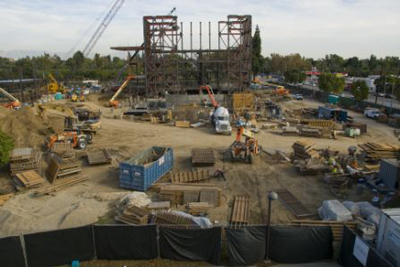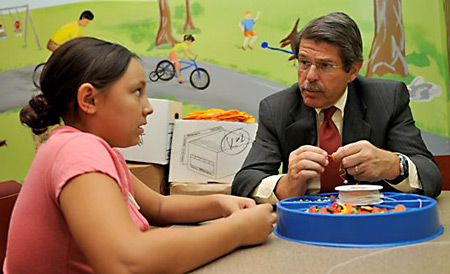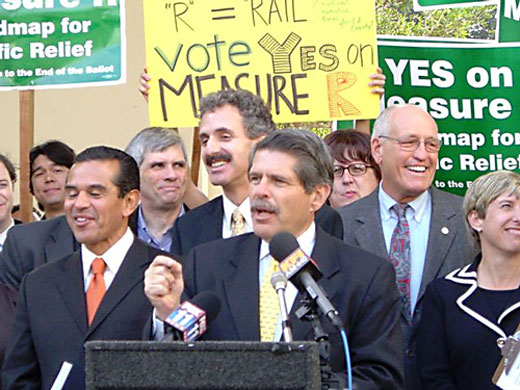For our state, a time for statesmanship
February 24, 2009

Construction was halted in February on the Valley Performing Arts Center.
After decades of dreaming and planning, girders now rise from the dirt on the campus of Cal State Northridge—the steel bones of what promises to be the region’s next cultural landmark, the Valley Performing Arts Center.
But these days, the construction site is infuriatingly quiet—a quiet that speaks loudly to the inexcusable failure of the state of California to pass a budget and close a $42-billion deficit. Last month, to save money, the department of finance halted all bond-funded construction, including the Valley Performing Arts Center.
The project’s price-tag is now certain to soar because of a delay expected to last at least three-months. But worse, 150 construction workers are suddenly jobless. Their households have seen a recession turn into a depression. Who knows what struggles await them in these worst of economic times.
From one end of the state to the other, the budget deadlock is stealing jobs and threatening scores of projects and programs—from transportation improvements to neighborhood health clinics—as Sacramento finds it easier to get to “no” than to “yes.”
While the President and Congress are trying to jump start the economy, our state has become the home of the anti-stimulus, reducing employment, deferring payments of various sorts and generally constricting the flow of money into our state economy. California’s credit rating is now dead last in the nation, making money even harder and more costly to come by. The dollars we’re unnecessarily spending on debt service could be used to strengthen our schools and services.
By allowing the state’s deficit to balloon during the protracted budget negotiations, we’ve shot ourselves in the foot—and hit an artery. And the longer the stalemate continues, the more extreme the remedies, potentially ripping holes in vital safety-net services for the poor.
Ironically, the state now is looking for a bailout from hard-pressed local governments, who’ve seen their revenues from property taxes evaporate as home sales plunge and foreclosures rise. The Metropolitan Transportation Authority, for example, has been asked to pony up millions to cover state costs for transit projects that otherwise might not get built.
Even worse, Sacramento has asked California’s counties to absorb the cost of state-mandated social programs that cost tens of millions of dollars each month. In short order, we’d be out of cash to provide police and emergency services in the event of a natural disaster. Even if we could agree to underwrite state programs, odds are it would be a long time (if ever) before we’d see a dime repaid.
The moment has long come to put political differences aside. The consequences of this endless intransigence are harmful to every man, woman and child in this state-even more so for the most vulnerable among us. Lives and livelihoods are at stake.
It’s time for all of us to act like statesmen for a change.
Click here to read more blog entries.
Yaroslavsky announces grant awards for trail lands acquisition
February 24, 2009
Board of Supervisors Chairman Zev Yaroslavsky has announced approval of $2.32 million in grant funding to help purchase six parcels of prime open space in the Santa Monica Mountains to expand the County’s hiking and equestrian trail system. The money comes from competitive grant awards under the Natural Land for Trails program funded through Proposition A, a park and open-space measure championed by Yaroslavsky and approved by County voters in 1996. The projects, funded by a combination of sources, include: Lindero Creek, an Agoura Hills city park; the Upper Topanga Canyon Trail Connection, between Summit to Summit at Henry Ridge Motorway; Cold Creek Trail, in the Cold Creek Preserve Area; Cold Creek High Trail, part of the remaining 145 acres identified for open space and trail acquisition in the planned 520-acre Cold Creek Restoration Plan; Upper Solstice Canyon – Solstice Canyon Trail, considered a “critical acquisition” in the Upper Solstice Canyon; and Corral Canyon, toward the purchase of a parcel adjacent to Malibu Creek State Park, surrounded on three sides by public parkland. See press release for further details on these grants; visit SD3 photo gallery to see other Third District Prop. A-funded parks and recreation projects; or Regional Park and Open Space District to learn more about the County’s programs to preserve and protect open space and improve neighborhood parks.
Van Nuys courthouse opens child-friendly waiting room
February 4, 2009

Supervisor Zev Yaroslavsky strings beads with a youngster at the new Van Nuys Courthouse Waiting Room, which offers a reassuring and child-friendly environment for youngsters whose parents or guardians are involved in various types of court-related business such as attending hearings, filing court papers, or seeking advice from the Self-Help Legal Access Center. The Waiting Room frees up parents to deal with their legal issues, secure in the knowledge that their children are safe, entertained and well supervised. The Waiting Room also spares the children from tedious, complicated and sometimes heated court proceedings. Yaroslavsky’s office contributed roughly 80% of the project’s capital budget costs in partnership with the Valley Community Legal Foundation of the San Fernando Valley Bar Association, which contributed the balance. (11/20/08)
Traffic & transit measure R passes
January 18, 2009

Supervisor Zev Yaroslavsky hailed voter passage of County Measure R, an ambitious 30-year investment program aimed at relieving traffic congestion, repairing roads and highways, and extending the County’s subway and light-rail transit lines throughout the region. The current tally Countywide stands at 67.3% – 32.7%, but Third District voters approved the measure 72.9% – 27.1%, with support especially high in areas where traffic congestion is most acute. Here’s how Third District communities voted:
- Agoura: 63.6% – 34.6%
- Agoura Hills: 60.4% – 39.6%
- Beverly Hills: 74.7% – 25.2%
- Calabasas: 64.2% – 35.8%
- Hidden Hills: 60.6% – 39.4%
- Los Angeles: 72% – 28%
- Malibu: 69.2% – 30.8%
- Malibu Heights: 68.6% – 31.4%
- San Fernando: 70.9% – 29.1%
- Santa Monica: 77.3% – 22.7%
- Topanga: 73.7% – 26.3%
- West Hills (uninc.): 62% – 38%
- West Hollywood: 83.6% – 16.4%
- Westlake Village: 59.9% – 40.1%
For full details on how Measure R will work, the projects it funds and the communities it serves, visit Metro and Measure R.









 Check for the latest closure information
Check for the latest closure information








